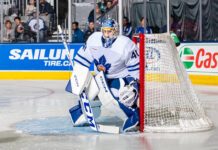Former Bruins GM Harry Sinden had a great quote on being a GM in the book Behind the Moves:
[quote_box_center]“I think the bottom line is pretty simple: who can play and who can’t play. That’s the bottom line. That is the fundamental job of the GM. Most GMs, if they didn’t have to make that call, [anybody] could do it, because administratively, it’s [straightforward]. There is a little more involvement because you have to play how you’re going to filed the team, make such things as a salary cap work, but that’s just mechanics. You read the CBA once and you go through a couple of incidents with it. ‘Capology’—it’s nonsense and a myth to think that that’s the most important part of the GM’s job, it’s definitely secondary… You’ve got to know who can play and who can’t, because you’re held responsible for that, and it’s very risky if you entrust that [to assistants] without having any input at all.”[/quote_box_center]
“Who can play and who can’t play,” that’s really the bottom line for the Leafs.
With only five forwards under contract for next season at the moment (not including Colton Orr or Frazer McLaren), the Leafs have a lot of holes to fill and some internal solutions on the Marlies.
In my first piece on the ‘low-hanging fruit’ options for the Leafs to get better, I discussed their lack of depth scoring last year and how they are set up to easily improve, especially when it comes to their 7-8-9 forwards.
The key for the Leafs will be determining, roughly, where to slot these players in the line-up so that they know what holes they need to fill elsewhere. In other words, Peter Holland being able to play 3C instead of 4C is a big difference. The same can be said for a few others in the Marlies system such as Carter Ashton and Jerry D’Amigo. Are these fourth liners? Can they reasonably pencil in one of these guys as a third liner and get good minutes and production here?
On the flipside, if they sign a bunch of veterans to good-sized deals, they will block opportunities and openings for these kids to move up the line-up. For example, if Bolland is locked up to a big deal, Holland isn’t going to push out any of the top three centers on the team in that scenario (Bozak and Kadri being the others). That means the only way he moves up is if there is an injury or he switches positions. These are things the management staff has to weigh this summer.
Marlies coach Steve Spott has been vocal in support of these young players receiving NHL opportunity. With so many open spots on the Leafs roster at the moment, it is a safe bet that they are going to at least receive some long looks. Here is a sampling of some of Spott’s comments this season.
On Carter Ashton:
[quote_box_center]“Anytime you get sent down it’s never a positive for a player that’s an NHL player. And he’s an NHL player.”[/quote_box_center]
On Jerry D’Amigo:
[quote_box_center]“Sometimes we underestimate how good of a goal scorer he is.”
“To get that call and be up there for quite some time, I thought did wonders for his confidence and he knows now he’s close to being an NHL player.”[/quote_box_center]
On Peter Holland:
[quote_box_center]“He’s a puck possession guy, he likes to move the puck and he’s just so dynamic through the neutral zone.”
“He’s an NHL centreman.”[/quote_box_center]
On Petter Granberg:
[quote_box_center]“Elite shutdown defenseman with the ability to kill penalties and I think he’s going to be a Toronto Maple Leaf at some point.” [/quote_box_center]
The last time the Marlies made a deep playoff run they were led by a handful of young players sent down by the Leafs after they failed to make the playoffs. Players such as Jake Gardiner, Nazem Kadri and Matt Frattin combined with veterans like Mike Zigomanis and Ryan Hamilton to push the team to the finals.
During that 2011-2012 season, the Marlies top 5 scorers were:
- Mike Zigomanis
- Ryan Hamilton
- Marcel Mueller
- Greg Scott
- Jerry D’Amigo
Almost every player in the top five we already knew weren’t going to be NHLers at that point. This season is a different scenario as the top five scorers were:
- TJ Brennan
- Spencer Abbott
- Greg McKegg
- Josh Leivo
- Sam Carrick
To say nothing of the seasons that D’Amigo and Ashton were having before being called up and yo-yo’d around. There’s a chance you’re looking at three NHLers, maybe four with the right bounces, out of that group above alone.
This team doesn’t have the same star power as the previous powerhouse Marlies team because there is nobody that compares to Kadri or Gardiner talent wise, but the depth here is impressive. They roll four good lines while legitimate contributors sit every night. They really have been led by their young players.
Was looking at this this morning… #Marlies have the 27th oldest team in the AHL (very young)… also the heaviest and 4th tallest.
— Stephen Burtch (@SteveBurtch) May 13, 2014
This team is young, big, and heavy. That should serve as a nice addition to one of the weakest bottom six groups in hockey last season, adding not only some scoring but the other little things to help push the Leafs forward such as an ability to create an actual cycle in the offensive zone and help kill penalties (Marlies were 11th this year killing a little over 83%).
Of interest on this note is the report that the Leafs interviewed DJ Smith for the Marlies coaching gig. Even though Smith signed a deal in Oshawa a day later, the report in and of itself is interesting because it might be foreshadowing a potential promotion for someone on the Marlies coaching staff (if it’s not head coach Steve Spott, it could be one of the assistants, Derek King or Gord Dineen). Usually when these promotions from within happen the kids on the farm team benefit tremendously. Just this season in Tampa we saw Cooper give a number of kids he once had in the AHL long looks and real opportunities for the Bolts, and it paid off.
Years ago, when he was promoted from AHL head coach to NHL head coach in Toronto, Paul Maurice brought up players like Johnny Pohl and Bates Battaglia, made Ian White a full-timer, and even provided opportunities to kids like Brendan Bell and Kris Newbury to show what they can do in the NHL. It comes with the territory of promoting AHL coaches because they fight for the guys who got them the promotion in the first place.
There are future NHLers on the Marlies right now, which goes without saying. With an average age of roughly 23, full of draft picks and achieving post-season success, nobody should expect anything less. But it is up to the Leafs to make the right decisions now on who goes, who stays, and who should be a Leaf next season.
Last Fall, Joe Colborne had an awful training camp and preseason and the Leafs ultimately decided to give up on him and trade him away to Calgary for what ended up being a 4th rounder. Is it a huge, franchise altering mistake of a deal? No. But Colborne’s 10 goals and 28 points would have ranked him as the Leafs best bottom six producing forward ahead of Nik Kulemin’s 9 goals and 20 points. They have to do a better job of integrating these kids into the line-up, setting them up to succeed, and ultimately developing them.
The final four teams in the AHL playoffs last season were Syracuse, Wilkes-Barre, Grand Rapids, and OKC. Syracuse and Grand Rapids both had seven players go onto play a notable amount of NHL games the following season (at least over 30), while Wilkes Barre had two and OKC had three. Syracuse is Tampa’s affiliate and Grand Rapids is Detroit’s, so those numbers are a little high considering their NHL team’s injuries. Considering the Leafs have so many openings available for kids to snap up, though, it’s not unreasonable to think 3-5 kids on this Marlies playoff run can be productive in the NHL next season.
The challenge is figuring out who slots where and who is good enough to make the team. There are essentially four AHL PPG players there: Brennan, Abbott, Holland, and Ashton. Not to mention playoff leading scorer Jerry D’Amigo. Brennan is a UFA this summer while the other four are RFAs. There are three other kids on defence who figure to get good looks in Stuart Percy, Petter Granberg, and Andrew MacWilliam.
The defence will get its own separate column, but surely the Leafs can find three forwards on the Marlies capable of combining for and producing more than the zero points in the 99 games Smithson, Orr and McLaren played in as a trio. Holland already produced more than McClement in 38 less games last season.
It’s just up to Leafs management and coaches now to make the right calls on who to promote, where to slot them, and how to develop them properly in the NHL. In doing so, they’d help round out their roster to be much better than it was a season ago. That would be a big boost to a team that relied on their top line far too much in 2013-14.














![John Gruden after the Leafs prospects’ 4-1 win over Montreal: “[Vyacheslav Peksa] looked really comfortable in the net… We wouldn’t have won without him” John Gruden, head coach of the Toronto Marlies](https://mapleleafshotstove.com/wp-content/uploads/2025/09/gruden-post-game-sep-14-218x150.jpg)

















